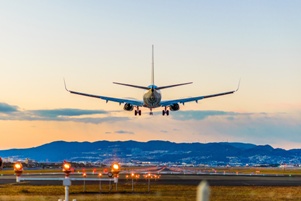Liability for Takeoff and Landing Accidents on Commercial Flights
 Although flying is one of the safest ways to travel, there is always a risk of an injury aboard any commercial flight. When accidents occur, they are overwhelmingly likely to take place during the first and last few minutes of the flight, making takeoff and landing maneuvers extremely dangerous for passengers and cabin crew. Some flight officials even refer to these periods as “plus three minus eight,” with as much as 80 percent of all crashes occurring within the first three minutes of takeoff or in the last eight minutes before landing.
Although flying is one of the safest ways to travel, there is always a risk of an injury aboard any commercial flight. When accidents occur, they are overwhelmingly likely to take place during the first and last few minutes of the flight, making takeoff and landing maneuvers extremely dangerous for passengers and cabin crew. Some flight officials even refer to these periods as “plus three minus eight,” with as much as 80 percent of all crashes occurring within the first three minutes of takeoff or in the last eight minutes before landing.
The Many Different Types of Takeoff and Landing Accidents
A study released by airplane giant Boeing discovered that 48 percent of all fatal accidents worldwide between 2007 and 2016 occurred during the aircraft’s final descent and landing. Although final approach and landing make up less than 5 percent of the total journey, it is the most hazardous time for commercial flights, resulting in nearly half of all onboard fatalities for the same period.
The second-most perilous stage of flight is during takeoff and initial climb. Although only responsible for a combined 13 percent of fatal incidents, the airplane is accelerating rapidly in close proximity to ground crews, other planes, and high wind resistance. There are many maneuvers required to take the airplane up to cruising altitude, and even a small mistake can cause serious injuries.
Common causes of takeoff and landing accidents include:
- Collisions with ground personnel. Overshooting a runway can cause a collision with ground crews or vehicles that were not cleared to cross the tarmac.
- Bad weather. Poor weather conditions may make it more difficult for a pilot to control speed or keep the plane level when in close proximity to the ground.
- Collisions between planes. Airplane collisions may occur during taxiing, from poor visibility during descent, or if two planes are directed to the same runway during takeoff and landing.
- Rough landings that cause injuries inside the aircraft. A pilot may be able to avoid collisions during takeoff and landing, but evasive action can still cause trauma to passengers. Many falling luggage injuries and blunt trauma incidents occur as a result of rough landings, turns, or sudden drops in altitude.
Liability in Takeoff and Landing Accidents
There may be many people who share fault for commercial airline accidents, and your attorney will have to gather evidence in order to determine who can be held responsible. Common sources of evidence may include the plane’s flight data recorder, the wreckage of the plane, eyewitness accounts, and recordings from airport surveillance cameras.
Responsibility for a takeoff or landing injury may fall on:
- Pilots. In a recent study examining the causes of 700 fatal commercial aviation accidents between 1990 and 2006, researchers identified pilot error as the cause of 40 percent of incidents and passenger fatalities. Pilots must be extremely skilled at flying in all kinds of conditions, and must be able to stabilize the aircraft during approach and descent. An investigation must be made to determine if the pilot was distracted, intoxicated, or performed an action without authorization from ground crews.
- Airplane manufacturers. Equipment failure is often a factor in fatal airline accidents, particularly engine failures, problems with electrical systems, and landing gear malfunction. Injured passengers may be able to file a product liability claim against manufacturers of a defective aircraft or its component parts.
- Mechanics and maintenance crews. Third-party maintenance crews could be held liable for injuries caused by failure to adequately repair or replace broken components, or the inability to identify a defect in a commissioned aircraft.
- Air traffic controllers. Air traffic controllers may be liable for accidents where planes were not spaced with the required minimum separation or if an aircraft was cleared to take off or land on a closed or incorrect runway.
- Airlines. Commercial airlines are ultimately responsible for the safety of their passengers and employees under the common carrier rule. Takeoff and landing incidents may be traced back to an airline’s unsafe operating procedures, allowing aging or outdated planes to remain in service, or failure to properly train its employees.
At GriffithLaw, we conduct a thorough investigation to determine who is responsible for your airline injury—and we do not collect any legal fees unless we recover compensation for you. Simply fill out the short contact form on this page to set up your no-cost injury consultation, or learn more about your rights in our free guide, The 10 Worst Mistakes You Can Make With Your Tennessee Injury Case.
|
Related Links: |

